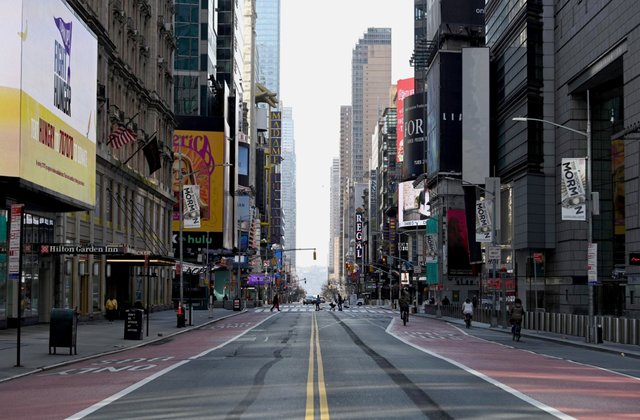The Lockdown Must End
April 30, 2020
States that haven’t locked down: Utah, North Dakota, South Dakota.
1. We have already flattened the curve
Social distancing works. We have gone from predictions of millions of deaths to hundreds of thousands and now we are predicting about 60 thousand deaths. This is with the likely over-reporting of death. Dr. Birx admitted the attribution of death to COVID-19 has been liberal. If the death count were limited to deaths directly caused by COVID-19, it would likely be even lower than this.
The most effective time for social distancing is early in a pandemic. By the time the lockdowns began, COVID-19 had already been seeded in the US for months, limiting the effectiveness of the lockdowns in the first place as the virus was already widespread.
2. Economic collapse and unemployment are destroying families
Each day the shutdown continues, we are losing approximately one million jobs, as evidenced by 16.5 million initial weekly jobless claims in three weeks. Many of these lost jobs will never return. If the lockdowns continue through April, we’ll be lucky if job losses are limited to 25 million.
The 16.5 million jobs lost thus far are only counting people who have filed jobless; it’s likely that the real number is much higher than this. In addition, there are millions of people not-technically-unemployed who have seen their incomes plummet. One example would be so-called gig workers, such as Uber and Lyft drivers. Realtors are also suffering the same fate.
3. We have not saturated the health care system
Although the ER and ICU capacity has increased in many locations, overall healthcare system capacity has decreased dramatically, as all non-COVID and non-emergent care is being neglected. This has led to layoffs of healthcare workers and delays in care for countless patients, which will result in a range of negative consequences.
Countless patients are not receiving the care they need in a timely manner. In medicine, timing is of the essence, so even receiving the same exact service in the future comes at a price. Many important services are being delayed: organ donations, screening colonoscopies, and many other elective procedures. It is very important to note that elective medical care is not useless medical care; rather, it’s simply meaningful and necessary medical care that is scheduled in advance and not performed on an emergency basis.
4. Suicide may kill almost as many people as COVID-19 this year
In 2018, there were 48,344 recorded suicides. Economic ruin results in a wide range of health problems, suicide, mental health issues, loss of health insurance, reluctance to visit doctors in light of financial hardship, and increases in substance abuse. This is on top of the delay in non-COVID care.
5. The mortality was likely overestimated
The IHME model has recently decreased the likely deaths from this pandemic to around 60,000 from earlier estimates of 1–2 million. The early reports of a 3–4% case fatality rate (CFR) are likely misleading. The numbers miss those who are asymptomatic or recovered at home without seeking testing. What we really need to know is the infection mortality rate (IFR). Fortunately, we have some good clues. Looking at the data from the Diamond Princess cruise ship, the infection fatality rate on the cruise ship was 1%. However, the average age of people on the cruise ship was much higher than the age of the average American. When you adjust for the differences in age between the cruise ship and America, you see that the IFR should be about 0.1%.
6. Children are at almost no risk from this disease
The CDC estimates 37 to 187 children die every year, not from Covid-19, from the flu.This year we have lost 105 children from the flu. Yet, we have closed every school in America. Education is vitally important and a whole generation will miss a fourth of this school year. Closing schools also goes a long way towards limiting the development of herd immunity.
7. PPE was limited but is now becoming more available
The lack of personal protective equipment (PPE) facing US healthcare workers is unfair and wrong. Yet, as the curve has flattened, it seems more hospitals have found adequate PPE. The CDC estimates a possible second wave would be at least 150 days from the end of the lockdown, possibly this fall. Ending the lockdowns would have no effect on the PPE for the current crisis. We would have plenty of time to prepare for a possible second wave.
8. Authorities should show clear evidence regarding the benefits of indefinite lockdown
Those who want to continue the lockdown indefinitely should show clear evidence regarding the benefits of indefinite lockdown. There needs to be a clear reliable model that shows how many additional lives will be saved considering we have already flattened the curve and there is essentially no further risk of overwhelming the health care system. The previous models were wrong. The consequences of indefinite lockdown are quite staggering, to the tune of one million jobs lost per day.












